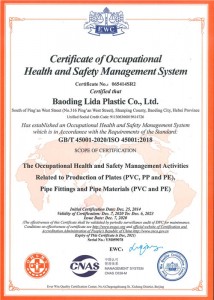10 сар . 09, 2024 23:45 Back to list
drain pipe fittings
Understanding Drain Pipe Fittings A Comprehensive Guide
When it comes to home plumbing, the components that make up your drainage system are crucial for maintaining an effective and efficient waste removal system. Among these components, drain pipe fittings play a pivotal role in ensuring that wastewater flows smoothly from your fixtures to the municipal sewer system or your home’s septic tank. In this article, we will explore the different types of drain pipe fittings, their functions, and installation tips.
What are Drain Pipe Fittings?
Drain pipe fittings are specialized connectors used to join different sections of drain pipes or to change the direction of the pipeline. These fittings come in various shapes and sizes, designed to accommodate various plumbing needs. Common drain pipe fittings include couplings, elbows, tees, and adapters. Each fitting serves a unique purpose that contributes to the overall functionality of the drainage system.
Types of Drain Pipe Fittings
1. Couplings This type of fitting is used to connect two straight sections of pipe. Couplings can be made from various materials, including PVC, ABS, and metal, depending on the application. They help ensure a watertight seal, which is crucial in preventing leaks.
2. Elbows Elbow fittings are used to change the direction of the pipe. Available in various angles, including 45-degree and 90-degree options, these fittings are essential in navigating plumbing systems around obstacles. In drainage systems, elbows help direct wastewater away from fixtures and towards the main drain or sewer line.
3. Tees Tee fittings allow for the connection of three pipes—two in one direction and one in the perpendicular direction. This is especially useful for creating branches in a plumbing system. For instance, a tee can link a new fixture, such as a sink, to an existing drain line, ensuring efficient waste flow.
4. Adapters Adapters are fittings used to connect two pipes of different sizes or materials. They ensure compatibility between, for example, a plastic drain pipe and a metal fitting. Selecting the right adapter is essential for maintaining a secure connection and preventing leaks.
5. P-Traps While not a fitting in the traditional sense, P-traps are integral to any drainage system, particularly under sinks. They prevent sewer gases from entering the home and trap debris, preventing clogs in the drainage system.
Materials Used in Drain Pipe Fittings
Drain pipe fittings are available in several materials, each suited for different applications
- PVC (Polyvinyl Chloride) Lightweight and easy to install, PVC is the most common material used in residential drainage systems. It is resistant to corrosion and offers excellent durability.
drain pipe fittings

- ABS (Acrylonitrile Butadiene Styrene) Similar to PVC but with superior impact resistance, ABS is often used in colder climates where impact can be an issue. However, it's generally more expensive.
- Cast Iron This traditional material is known for its durability and noise-dampening properties. Cast iron fittings are typically used in larger buildings or in situations where sound reduction is a priority.
- Copper Though less common for drains, copper is sometimes used in older systems. It is durable but can be prone to corrosion over time.
Installation Tips
Proper installation of drain pipe fittings is crucial for ensuring a leak-free system. Here are some tips to consider
1. Cutting Pipes Use a pipe cutter for clean cuts. Jagged edges can lead to leaks.
2. Chamfering Edges Be sure to chamfer the edges of cut pipes to prevent the fitting from cracking when inserted.
3. Use Proper Adhesives When working with PVC or ABS fittings, make sure to use the appropriate solvent cement for a strong bond.
4. Securing Connections Ensure all connections are tightly secured, and use plumber’s tape on threaded joints to enhance the seal.
5. Follow Local Codes Always adhere to local plumbing codes and regulations when installing drainage systems to avoid potential hazards.
Conclusion
Understanding the different components of drain pipe fittings is vital for anyone involved in home plumbing. By using the right fittings and ensuring correct installation, homeowners can maintain effective drainage systems that keep their homes safe and comfortable. Whether you are a seasoned plumber or a DIY enthusiast, knowledge of these fundamental components will undoubtedly aid in your plumbing projects.
-
High-Quality PPR Pipes and Fittings Durable ERA PPR & PVC PPR Solutions
NewsJul.08,2025
-
Black HDPE Cutting Board - Durable, Non-Porous & Food Safe HDPE Plastic Cutting Board
NewsJul.08,2025
-
High-Quality CPVC Panel Durable HDPE & PVC Panels Supplier
NewsJul.08,2025
-
Double PE Welding Rod Supplier - High Strength, Durable & Versatile Welding Solutions
NewsJul.07,2025
-
High-Quality PVC-O Pipe Supplier Durable 75mm PVC Pipe & Connections Leading PVC Pipe Company
NewsJul.07,2025
-
HDPE Drainage Pipe Supplier – Durable & Corrosion-Resistant Solutions
NewsJul.06,2025

